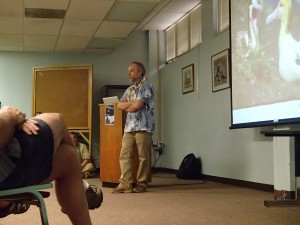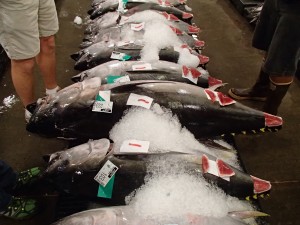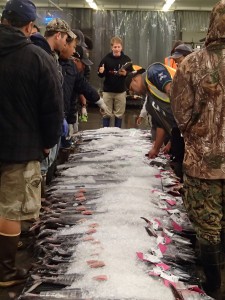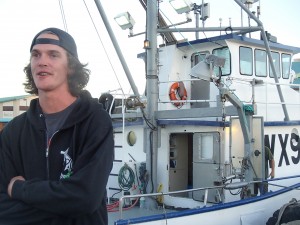“Don’t write everything you know, use everything you know to determine what you write”-the first axiom Carl Safina shared today in a seminar on albatross. Communication is an integral part of conservation. Environmental managers can learn a lot from Carl Safina, whose works such as the Eye of the Albatross exemplify the physical and cultural connections between humans and the ocean. With this in mind, I’ll attempt to portray our day’s events without overwhelming information (there was a lot).

Our day began at the Honolulu Fish Auction, the only fresh tuna auction in the U.S. Our 5am wakeup was relatively late in the process, which begins around 1am when vessels unload their fresh catch. The fish are organized by vessel and species, weighed, tagged, and displayed on pallets. Buyers scrutinize the rows of pelagic species, assessing fat content and coloration of flesh samples from each fish. It’s somewhat of a gamble, as the majority of the fish remains intact. A United Fishing Agency auctioneer walks down the rows auctioning each individual fish. Although the auction is open to the public, it ain’t amateur hour. The auctioneer speaks at a blistering, incomprehensible pace. Buyers may be good friends outside of the auction, but bidding is a seriously competitive, psychological game. John Hernandez, an experienced buyer for John’s Fresh Fish (his wife is the boss), explained that the auctioneer starts at a higher price, lowers it, and increases again until someone bids. The auctioneer marks the final price, the buyer places their company tag on the fish, and Agency officials apply a final bar code to the tag.


Founded in 1952, the auction’s competitive bidding scheme promotes better prices for fishers, and fresher fish for buyers by eliminating wholesale middlemen that dictate other markets. The organized tagging system and transparency of the entire process ensures traceability. The highest price we observed was $13.90/lb for a 164lb yellowfin tuna purchased by John himself. He exports the majority of his fish to the mainland, so it may be coming to a restaurant near you!

Overall, the auction was a unique and positive experience giving us new insight into the fishing industry.
Side note: I never enjoy seeing a dead shark and although they are not targeted in this market (two shark (mano) gods are revered in Hawaiian mythology) I’m not sure if I feel better or worse about the idea that two Makos will sell for only $3-4/lb…BUT I DIGRESS…
Our next stop of the day was to a longline fishing vessel captained by a young fisherman named Travis. If not for the setting of a 70ft-fishing vessel, Travis appears a typical haole surfer dude, in need of a haircut. All of that is true. But he is also a 4th generation fisherman who spends approximately 280 days a year at sea. He detailed his latest 22-day voyage, which included 18-20 hour workdays. He and his small crew traveled 600 miles off the coast and then fished 13 consecutive days. They start fishing at sunrise to avoid squid predation and work for 6 hours straight to set 3,000 hooks. A hydraulic motorized spool is adjusted to the desired rotation per minute (rpm) and beeps every 6 seconds, indicating when to set a new hook. It is a tedious task, essential for timing and efficiency. Haul back time is between 12-14 hrs and is dependent on weather and the amount of fish on the lines.

Aside from a good haul, Travis expressed a pride and respect for the ocean that motivates his work. In contrast to a misguided popular view, fishers take great pride in their work, value fishery resources for more than economic gain, and are often the source of novel management solutions.
We also had the privilege of speaking with Sean Martin, head of the Hawaii Longline Association. He described some of the regulations in place to reduce bycatch of protected species. Regulations range from the type of gear and how the gear is set, to how to handle incidental capture. The hook must be strong enough to retain the fish, but weak enough for false killer whales to free themselves. Lines must be set deep and out of reach of albatross. Circle hooks reduce harmful impacts on turtles. Captains and vessel owners are required to attend a workshop on protected species every year. Many regulations such as these are supported or have been developed by the fishers themselves. (DISCLAIMER: I do not mean to paint a rosy picture where fishers and regulations live harmoniously all the time. Good ol’ Carl informed us today “everyone is lying to you, if you go through life with that you will make fewer mistakes.” As a result, I am currently calling into question the past 26 years of my existence.) Sean also showed us how the Vessel Monitoring System (VMS) works. Each vessel has a black box on board recording position, speed, and information on fishing activity. Monitoring ensures vessels are avoiding restricted areas, and the Pacific longline fleet was the first to implement its use– just one example of how the Pacific fleet is considered at the forefront of the industry.

A final aphorism Carl Safina shared with us today was “hope motivates all work.” This idea was illustrated by our observations and discussions with various levels of the fishing industry. Marine conservation is daunting. We don’t have all the answers. However, none of us (buyers, fishers, managers) would do what we do if we didn’t see potential.

Thank You For Sharing
I Support You
I Love Fish